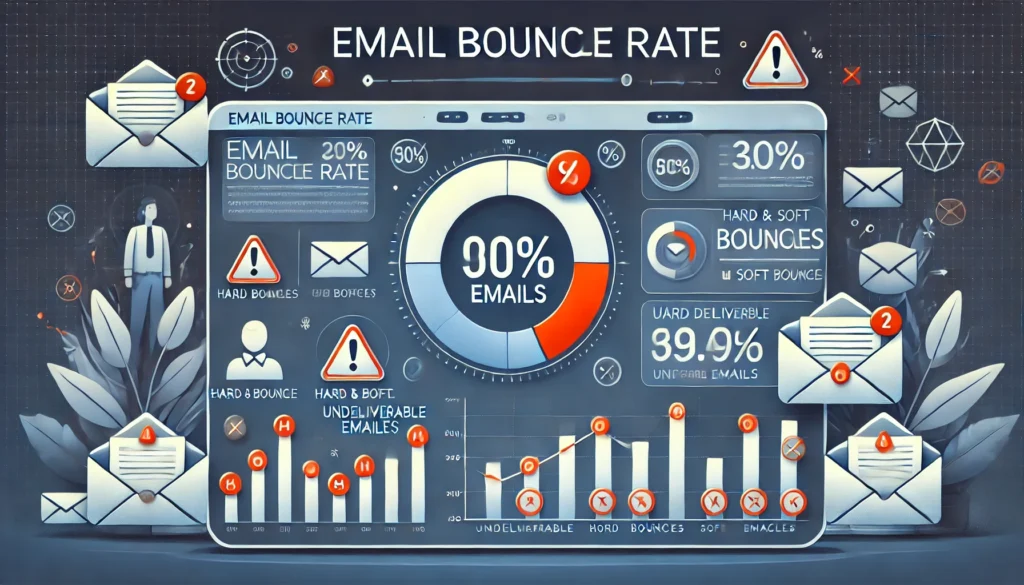The email bounce rate is a critical metric in email marketing that represents the percentage of emails sent that could not be delivered to the recipient’s inbox. High bounce rates can negatively impact your email marketing campaigns, reducing their effectiveness and harming your sender reputation. Understanding and managing your email bounce rate is essential for maintaining a healthy email list and achieving successful email marketing outcomes.
Types of Email Bounces
- Hard Bounces
- Definition: Hard bounces occur when an email is permanently undeliverable. This can happen due to invalid email addresses, non-existent domains, or recipient email servers blocking your emails.
- Causes:
- Incorrectly entered email addresses
- Deactivated or deleted email accounts
- Non-existent domain names
- Soft Bounces
- Definition: Soft bounces are temporary issues that prevent email delivery. These can often be resolved and the email may eventually be delivered.
- Causes:
- Recipient’s mailbox is full
- Email server is temporarily down
- Email message is too large
- Recipient’s email server is busy or experiencing issues
Calculating Email Bounce Rate
The email bounce rate is calculated using the following formula:
Bounce Rate=(Number of Bounced Emails/Number of Emails Sent)×100
For example, if you sent 1,000 emails and 50 of them bounced, your bounce rate would be:
Bounce Rate=(50/1000)×100=5%
Importance of Managing Email Bounce Rate
- Sender Reputation
- A high bounce rate can damage your sender reputation. Email service providers (ESPs) monitor bounce rates and may flag or block senders with high bounce rates, leading to reduced deliverability.
- Deliverability
- Managing bounce rates helps ensure that your emails reach your recipients’ inboxes. High bounce rates can lead to emails being filtered into spam folders or blocked entirely.
- Email List Quality
- Monitoring bounce rates helps maintain a high-quality email list. Removing invalid or inactive email addresses improves engagement rates and the overall effectiveness of your email campaigns.
Strategies to Reduce Email Bounce Rate
- Validate Email Addresses
- Use email validation tools to check the validity of email addresses at the point of collection. This helps catch typos, invalid domains, and non-existent email addresses before they enter your list.
- Use Double Opt-In
- Implement a double opt-in process where subscribers confirm their email addresses before being added to your list. This ensures that the email addresses are valid and that the subscribers genuinely want to receive your emails.
- Regular List Cleaning
- Periodically review and clean your email list to remove invalid, inactive, or outdated email addresses. This helps maintain a healthy and engaged list.
- Monitor and Analyze Bounce Reports
- Analyze bounce reports provided by your email service provider to understand the reasons for bounces. Take appropriate actions based on the type of bounce (hard or soft).
- Segment Your List
- Segment your email list to send targeted campaigns to specific groups of recipients. This can improve engagement and reduce the likelihood of bounces caused by irrelevant content.
- Maintain Email Hygiene
- Ensure your email content complies with email regulations and best practices. Avoid using spammy language, excessive images, or large attachments that could trigger bounces.
- Engage with Your Audience
- Regularly engage with your subscribers to keep them active and interested. Encourage them to update their email preferences and contact information.
Example Email Bounce Report
A typical email bounce report may include the following information:
- Email Address: The email address that bounced
- Bounce Type: Hard or soft bounce
- Bounce Reason: Specific reason for the bounce (e.g., invalid email address, mailbox full)
- Timestamp: The date and time when the bounce occurred
- Message ID: Unique identifier for the bounced email
Example Report:
| Email Address | Bounce Type | Bounce Reason | Timestamp | Message ID |
|---|---|---|---|---|
| john.doe@example.com | Hard | Invalid email address | 2023-08-07 10:00 AM | MSG12345 |
| jane.smith@example.com | Soft | Mailbox full | 2023-08-07 10:05 AM | MSG12346 |
| info@company.com | Hard | Non-existent domain | 2023-08-07 10:10 AM | MSG12347 |
Conclusion
Managing your email bounce rate is essential for maintaining a healthy email marketing strategy. By understanding the types of bounces, regularly cleaning your email list, and employing best practices, you can reduce your bounce rate, protect your sender reputation, and ensure higher deliverability rates. A well-maintained email list not only improves campaign performance but also fosters better engagement with your audience.




